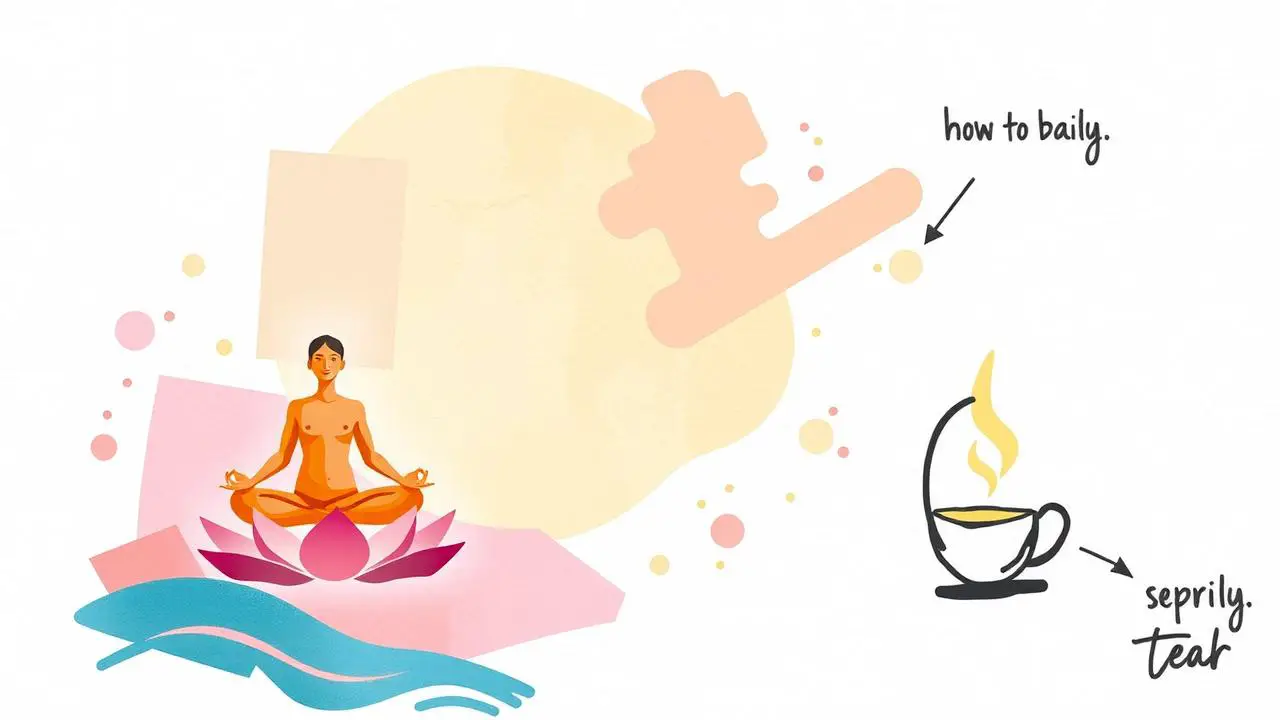Feeling overwhelmed and anxious? Wishing for peace and calm in your life, but unsure of how to start?
Mindfulness can be a great tool for coping with today’s stressors. It’s more than just a buzzword—it’s an effective method to clear the mind and find emotional balance. And the best part is that it works on anyone, regardless of their spirituality or faith.
Before we dive in further let’s establish, in plain English, what mindfulness is:
Mindfulness is simply the practice of being present in the moment, aware of your thoughts and feelings without becoming overly involved or reactive. It is a practice that emphasizes deep breathing and focus on the present moment in order to create a sense of inner peace and contentment and it encourages you to observe and be aware of what is happening both around you and within yourself without judgement.
So if you’re interested in learning more about mindfulness, then you’ve come to the right place! In this article I’ll explain what mindfulness is in plain English and give you some tips on how to incorporate it into your daily life.
Definition of Mindfulness
Mindfulness is the psychological process of purposely bringing one’s attention to experiences occurring in the present moment, which can be developed through the practice of meditation and other training. The idea of mindfulness has its roots in Buddhist spirituality, but is becoming more widely accepted in psychology and medicine outside a spiritual context.
The concept of mindfulness has been described by modern psychologists as “paying attention to present moment experience with openness, interest, and receptivity” (Bishop et al., 2004).
In simpler terms, this means being aware and alert without judging or reacting to your thoughts or feelings.
It involves observing with curiosity what arises in your awareness without clinging to it or pushing it away.
This type of meditation is free from content and context, meaning it involves simply noticing what comes up in the mind and body at any given point.
This can include physical sensations such as breathing, sound around you, sights that catch your attention or anything else that may arise throughout each day.
Benefits of Mindfulness
Mindfulness can be an incredibly powerful tool to help us better understand ourselves, increase our resilience and well-being, and thrive in the face of life’s obstacles.
Practiced regularly, it can lead to an improved sense of focus, concentration, clarity of mind and emotional regulation.
Research shows that when we become more mindful, our brains literally become more adept at reducing stress and responding to it with greater resilience and ease.
With regular practice, mindfulness increases the brain’s gray matter density in the areas associated with emotion regulation; the ability to empathize; executive cognitive functioning; learning capacity; memory recall and a host of other benefits.
Specifically related to emotional wellbeing, studies show that regular mindfulness practice can reduce levels of anxiety, depression, stress hormones like cortisol, low self-esteem issues, unhealthy coping mechanisms and even symptoms related to trauma. Mindfulness has been studied as a powerful tool for reducing chronic pain suffered by people with conditions like fibromyalgia too.
Through cultivating greater awareness around our thoughts and emotions, and ultimately our habits, we come closer to making choices that will support our overall well-being in both the short term as well as long term.
We’re better able to recognize what serves us best as opposed to what might seem pleasing in the moment but ends up causing harm or discomfort down the road.
Mindfulness Practices
Mindfulness is a practice that involves focusing on the present moment while paying attention to your inner thoughts and feelings.
It helps to create a mental space where you can become more aware of your thoughts and feelings without feeling overwhelmed or stressed.
Mindfulness techniques, when practiced regularly can have a profound impact on your mental clarity and wellbeing. Let’s look into some mindfulness practices in more detail.
Meditation
Meditation is a form of mindfulness that allows us to become fully present with ourselves and our surroundings.
It involves becoming aware of the sounds, sensations, and thoughts we experience in each moment. During meditation, we can practice focusing on our breath to bring our minds back to the present moment when it wanders.
With consistent practice, we can learn to remove ourselves from situations that are causing us distress or discomfort and become more in tune with the positive aspects of life.
While there are many forms of meditation, such as relaxation exercises, guided visualizations, mantras and mindfulness meditations, all forms involve sitting in a comfortable position and focusing inwardly on calming the mind.
The benefits of meditation are well researched, and those with meditation experience in everyday life are found to have better mental health and well-being.
Practicing regular meditation can help reduce stress and anxiety levels and improve concentration, decision-making ability, self-awareness and overall wellbeing.
Breathwork
Breathwork is a core mindfulness practice that helps to bring the mind into a meditative state by focusing the attention on the movements of your breath.
This can be done in various ways, but it always involves being composed and present in the moment, becoming aware of each inhalation, exhalation and bodily sensation without attachment or judgment.
Breathwork has both calming and energizing effects that can focus or relax your body and mind, depending on your needs.
When practicing breathwork, you may find a comfortable seated position with your spine straightened or you may try a supported backbend or some other yoga practice.
Keeping your eyes closed not only will help to avoid distractions but also to cultivate the emotional connection between body and breath.
As you inhale and exhale deeply, become aware of each part of your body that is involved in the process: chest expanding with inhalations and contracting with exhalations; belly rising for inhalations and falling for exhalations.
Notice how feelings like calmness or alertness start to arise during different parts of this process.
You may start with short breaths as if they were restorative pauses between thoughts while increasing endurance with steady breaths allowing more natural “pauses” between exhales when all energy seems drained out of yourself until enough energy is built again to begin another cycle – pauses that create spaciousness within which deeply hidden emotions can arise without fear or shame.
Try not to control how breaths enter through your lungs but instead observe their journey through different parts of your body keeping an open mind about how beneficial this practice can be for you at any moment.
Allow yourself to surrender into letting go if any emotions arise throughout this process; feeling them fully until they are gone edging towards a deeper understanding about who you truly are within Spirit’s timeless wisdom outside linear time understanding.
Body Scanning
Body scanning is a mindfulness practice which uses focus on your body to bring yourself into the present moment. It is a form of progressive relaxation that helps to reduce sensations of physical and emotional tension, and can help us to become aware of changes in our body.
The body scan consists of systematically focusing your attention on each part of your body in turn, observing any sensations that arise. Be aware if there are areas of tightness or relaxation in the muscles, or pleasant or unpleasant sensations. Notice the texture, temperature, or colors that may come up. You can also pay attention to posture and alignment when doing a body scan.
When you become aware that your mind has wandered away from the sensations you are paying attention to, gently acknowledge this as part of being human, thank yourself for noticing and come back to focusing on the felt sense experience in your body.
Regular practices of physical relaxation help us observe our bodily habits which can be helpful in bringing awareness to how we move throughout our daily lives.
Doing regular practices like this also allows us to become more familiar with our bodies and how it is affected by different environments we enter into such as work meeting rooms or mobile phone conversations.
Loving-Kindness Meditation
Loving-Kindness meditation is a type of mindfulness practice that focuses on cultivating kindness, compassion, and love in yourself, for others, and for the world. It encourages us to open our hearts and minds to the things we find difficult – such as strong emotions like anger or fear – instead of pushing them away. It improves self-acceptance, understanding of others, and encourages connection with all living beings.
The practice begins by turning your attention inward to develop kindness and appreciation for yourself as a first step toward connecting with other living things.
You focus on repeating phrases such as “may I be happy” or “may I be free from suffering” before expanding your awareness to include wishes of well-being for people you know and even strangers.
After embodying those feelings you then expand those feelings of goodwill further outward to all living creatures.
The goal is to cultivate a deep abiding sense of interconnectedness with humanity at large while developing an unconditional sense of care and compassion towards others.
This kind of meditation can help us become more mindful throughout our day so that we can treat ourselves and others with dignity, respect, acceptance and understanding even when we face moments that bring out difficult emotions or challenge our values or beliefs.
Developing a Mindful Attitude
Developing a mindful attitude is a key element of practicing mindfulness. It is the foundation of an effective mindfulness practice.
It involves becoming aware of your inner life and all of the thoughts, feelings and body sensations that come with it as well as learning how to be present in the moment and not letting yourself get carried away by the thoughts, feelings and emotions that come up.
By becoming mindful of the inner life, you can create more balance and peace in your daily life.
Cultivating Awareness
Developing a mindful attitude starts with cultivating awareness. Practicing mindfulness encourages observation of thoughts, feelings, and body sensations without judgment and identifying emotions in yourself or others.
This can be accomplished in everyday life by taking time to pause and contemplate your words, actions and experiences throughout the day.
When tempted to react in the moment, take a deep breath, observe your thoughts without judgment and determine the best way to respond. While being present in the moment requires effort at first, practice will lead to a greater ability for self-reflection as well as improved communication skills with others.
Acceptance and Non-judgment
Acceptance and non-judgment are important elements of cultivating a mindful attitude. These concepts involve learning to observe our thoughts and feelings without judgment or criticism.
This allows us to have an awareness of the present moment without being overwhelmed by it. It also helps us to cultivate an inner sense of spaciousness that can increase our ability to cope with whatever life throws our way.
Acceptance means allowing ourselves to feel whatever emotions arise in the present moment, even if those emotions are uncomfortable or challenging. It also involves becoming attuned to subtle shifts in mood and attitude so that we can be more aware of what is happening inside ourselves and in the world around us.
Non-judgment involves freeing ourselves from the need to evaluate or label our thoughts, feelings, and experiences as good or bad in any way — it is simply a matter of setting aside expectations and opening up to understanding our own experience as well as others’ experiences with greater empathy and acceptance.
We learn how to step back from knee-jerk reactions that may not be beneficial for ourselves or those around us, allowing instead for conscious choice in how we respond. This practice can lead us towards adopting healthier ways of responding when faced with challenging situations or circumstances.
Letting Go
When we practice being mindful, we release our grip on expectations and outcomes. We become present to the moment and pay attention to what is happening around us.
This shift in focus helps us remain aware of our thoughts, avoiding becoming attached to nonessential ideas that can have a detrimental effect on our well-being.
For example, instead of worrying about what other people think or whether we are good enough, by letting go of those attachments, we make space for acceptance of ourselves and those around us.
We become more comfortable with a sense of openness that allows us to be introspective without judgment or criticism.
We are no longer lost in a sea of intrusive thoughts; instead, our energy is redirected into more constructive behaviors that nurture healthy relationships with ourselves and others.
Mindful acceptance can also lead to improved resilience and emotional regulation – two key components in cultivating contentment from within.
By releasing attempts at rigid control, we come to understand the interconnected nature of life’s joys and struggles – allowing greater freedom in exploring how best to respond rather than seeking ways to change the course each time an issue arises.
With this understanding comes increased self-knowledge as well as expanded awareness in all areas – socially, spiritually, physically and mentally – which allow us room to grow beyond habitual patterns toward deeper clarity and true understanding.
Mindful Living
Mindful living has many benefits, and it is something that anyone can do. In fact, mindfulness practices have been used for over 2,500 years to help people gain a more balanced perspective and become more aware of their thoughts and emotions.
Being Present
Mindfulness is a practice of remaining present in each moment and in daily activities. It can help to focus on the here and now, rather than getting lost in worries about the past or future.
Being mindful involves purposely paying attention to our experiences with an open, unbiased mindset. It’s a skill that can be developed through regular practice.
Mindfulness is a way to approach the many facets of life, such as eating, walking, working, and relationships in a conscious manner with more awareness and less judgment.
This includes noticing our thoughts, feelings and body sensations as they arise from moment to moment throughout the day.
Being present requires focusing attention on whatever task or activity is at hand — whether it’s being aware of how your body feels in an exercise class or washing dishes mindfully instead of letting other worries take away your focus on the task at hand.
Connecting with your senses helps bring about greater clarity and deeper insight into who you are and what you do at any given moment.
Additionally, stepping back from obsessive thinking can lead you to better decision-making and improved communication skills when interacting with colleagues or loved ones.
Mindful living supports physical health too — stress levels are lowered by taking deep breaths that help relax your body and clear away distracting thoughts — then you may find yourself able to make healthier choices regarding food as well as sleep quality that contribute positively towards wellbeing overall!
Practicing Gratitude
Gratitude is one of the most powerful and simple techniques for cultivating a mindful lifestyle. It has been proven to increase feelings of well-being, help us recognize our blessings, and purposefully shift our attention from worry and negative thinking to positive emotions.
It can be as easy as taking time out of each day, no matter how busy it may be, to acknowledge all the things you are grateful for in life.
This does not have to be a difficult process; simple thoughts are sufficient. For example, ‘I am grateful for my health’ or ‘I am thankful for my family’.
The more you practice, the easier it becomes—over time it can become second nature! It is important to also find ways to express your gratitude outwardly—letting people know when they made an impact in your life or showing someone appreciation with small token gifts such as flowers or chocolates.
Another great way of expressing gratitude is by writing thank-you notes and sending them through the mail or email if necessary.
Some people like to say specific affirmations each morning expressing their appreciation for different aspects of their lives such as friends, family, health, career and so on—this can serve a purposeful reminder of all that we have in life and encourage us to stay in a state of openness and joy amidst tough times.
Whatever method works best for you, make sure that gratitude becomes part of your daily routine.
Creating Balance
We all strive for balance. Life challenges us to find the middle path that fits with our own values and beliefs.
Mindful living uses the ancient practice of mindfulness to connect with ourselves, achieve greater clarity and stability on an emotional level, and maintain harmony in our personal and professional relationships.
Mindfulness is the practice of cultivating non-judgmental awareness of one’s present experience – be it physical, mental or emotional.
When we become mindfully aware of our thoughts and emotions, we create a sense of peace within ourselves that helps us respond more skillfully to difficult situations.
Through mindful practice, this sense of balance becomes more ingrained in us as a habit until it becomes second nature.
Creating balance doesn’t happen overnight – it requires dedication and patience but can be achieved through various mindfulness exercises such as meditation, yoga practices, mindful eating or walking outdoors.
Each exercise works towards helping you become aware of your thoughts, feelings and bodily sensations in order to reduce stress levels, improve concentration span and increase compassion for yourself and others around you.
By allowing yourself time to digest what is happening inside you as well as outside in your environment at any given moment , you will learn how to pause before responding so that whatever action is taken is done so wisely without unnecessary stress or lasting regret.
Can You Explain the Concept of Mindfulness in a Simple Way?
Mindfulness means being fully present and aware of your thoughts, feelings, and surroundings without judgment. It involves paying attention to the present moment and accepting it as it is. Understanding mindfulness concept is about cultivating a non-judgmental and compassionate mindset towards oneself and others.
Conclusion
The practical goal of mindfulness training is to break free from the binds of unconscious, habitual behavior and delusion.
The way to do that is to pay attention to direct experience with curiosity, openness, and acceptance. It’s a difficult process, because most of us are quite comfortable being bound by our habits, so we resist leaving that comfort zone.
It takes effort and it takes time but the rewards are worth it. That effort can be a meditation practice or any activity that incorporates mindfulness ideas into it throughout the day such as walking, eating and working.
There are many qualities you begin to develop when you practice mindfullness: mental clarity and stability; positive emotions like patience, kindness and equanimity; better relationships; improved physical health; increased success in life; peace of mind; greater well-being throughout life’s ups and downs; deep insight into reality.
Mindfulness meditation isn’t easy but it pays dividends over time if you practice regularly! The more you practice being mindful in every part of your life—from when you wake up until when you lay down your head—the better off you will be in so many ways!
Sources




